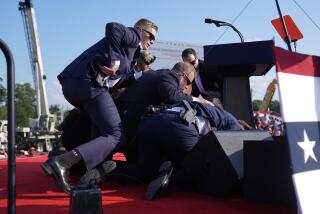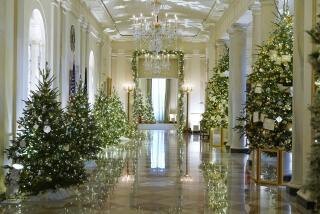Inside the White House
- Share via
President Clinton and his wife, Hillary, are working a floor apart in the West Wing of the White House, a 132-room mansion that has been residence and office for every President except George Washington. Site of the Oval Office, the West Wing was added to the main building in 1902; the East Wing in 1942. The living quarters are on the second and third floors of the main building, shown in cutaway drawings below.
THIRD FLOOR
A. Third floor: Two suites of rooms, two guest rooms, a laundry room, a game room and a changing room for the servants. President Ronald Reagan used the third floor much of the time while recovering from the assassination attempt in 1981.
B. Solarium: The glass-walled roof-top room is one of the most inviting places in the White House. Rosalynn Carter called it her favorite room in the living quarters. The Kennedy children attended school there.
SECOND FLOOR
Family Quarters
C. Bedroom area: (west end of second floor) Presidents and their wives have several private rooms, traditionally used as bedrooms and dressing rooms.
D. Lincoln Sitting Room: Ghost of Lincoln has been said to inhabit this room. Amy Carter and friends once tried to contact him with a Ouija board.
E. Dining and kitchen: (northwest corner) First family’s food comes out of a separate kitchen on the second floor. The first family pays for groceries purchased for private meals. They are purchased at wholesalers who have received Secret Service clearance and picked up by the agents. Once a suite, the area was converted by Jacqueline Kennedy, who found it hard to feed her two young children in the family dining area on the first floor.
F. Queen’s Bedroom: Used by visiting royalty
G. Lincoln Bedroom
H. Yellow Oval Room
I. Treaty Room
FIRST FLOOR
J. State Dining Room: used for large dinner or luncheon; seats 140
K. East Room*: The largest room in the White House; used for receptions, dinners, press conferences; site of many weddings
L. Blue Room*: considered the mansion’s most beautiful room; often used by Presidents to receive guests
M. Red Room*: for small receptions
N. Green Room*: Used as a dining room by Thomas Jefferson; now used for receptions
O. Cross Hall*: State rooms are grouped around this hallway
P. Entrance Hall*: Where state visitors enter and get their first impressions of the White House
(*Open to the public)
GROUND FLOOR
Q. Diplomatic Reception Room: Site of F.D.R.’s fireside chats
R. Library: Contains volumes of history, biography, fiction and the sciences, all by American authors
S. Vermeil Room: Contains extensive collection of vermeil (gilded silver)
T. China Room: Set aside in 1917 to display china and glass used by Presidents.
U. Map Room: Inspired by Winston Churchill’s map room London, it was a nerve center for tracking military movements in World War II.
THE WEST WING
The President and First Lady at Work
Access equals power in the West Wing of the White House. Here is where some of the key players are located in relation to the President:
Ground Floor
1. President Clinton, Oval Office
2. Clinton’s study
3. Mark D. Gearan, deputy chief of staff
4. Thomas (Mack) McLarty, chief of staff
5. Vice President Al Gore
6. Anthony Lake, national security adviser
7. Samuel (Sandy) Berger, deputy national security adviser
8. Dee Dee Myers, press secretary
9. George Stephanopoulos, communications director
10. Cabinet Room
Upper Floor
11. Hillary Rodham Clinton
12. Bernard Nussbaum, White House counsel
13. Vince Foster, deputy counsel
14. Robert E. Rubin, chairman, National Economic Council
15. Carol Rasco, assistant to the President for domestic policy
16. Margaret A. Williams, Hillary Clinton’s chief of staff
The Household Staff
The First Family can call on dozens of people for help in everything from sending invitations for State Dinners to preparing family meals. Most personnel carry over from one Administration to the next. A chief usher oversees the operations. He prepares the budget and handles purchases of food and supplies. The usual staffing includes:
3 ushers
8 housemaids
7 horsemen (maintenance)
1 maitre d’
6 butlers
3 chefs
3 doormen
2 launderers
2 pantrymen
1 administrative assistant
1 accountant
Assorted handymen and painters
Leisure Time
The 18-acre estate offers many diversions, including:
Swimming pool
65-seat theater
Exercise gym
Wine cellar
Tennis courts
Bowling lanes
Game room
Horseshoe court
Rooftop greenhouse
South Lawn (used for golf range)
Sources: The White House: An Historic Guide; The Living White House; From the Door of the White House
More to Read
Sign up for Essential California
The most important California stories and recommendations in your inbox every morning.
You may occasionally receive promotional content from the Los Angeles Times.













